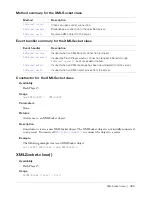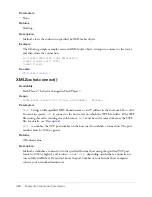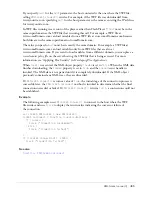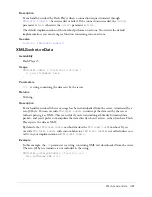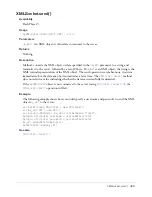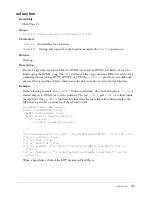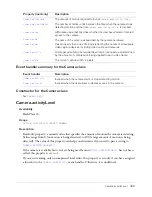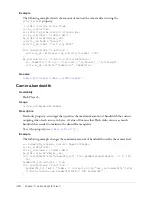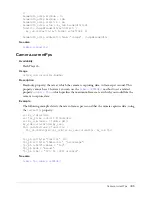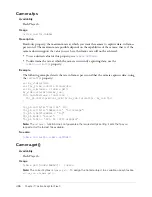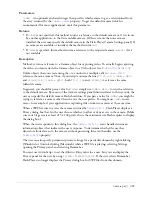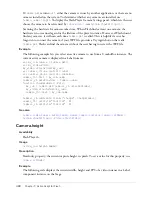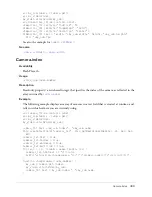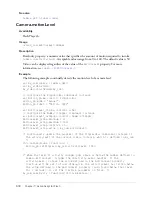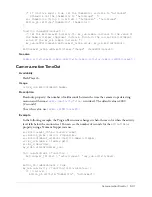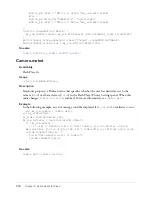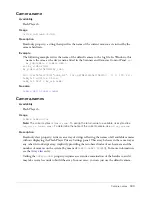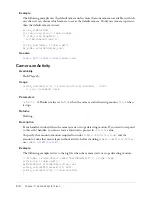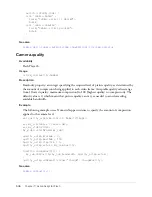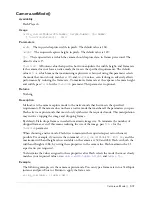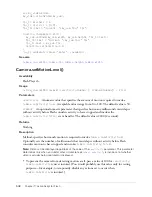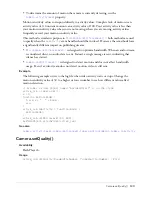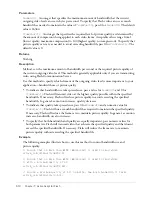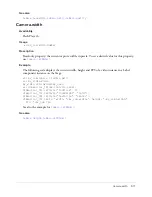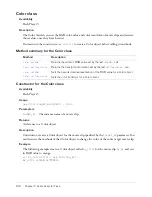
Camera.get()
497
Parameters
index
An optional zero-based integer that specifies which camera to get, as determined from
the array returned by the
Camera.names
property.
To get the default camera (which is
recommended for most applications), omit this parameter.
Returns
•
If
index
is not specified, this method returns a reference to the default camera or, if it is in use
by another application, to the first available camera. (If there is more than one camera
installed, the user may specify the default camera in the Flash Player Camera Settings panel.) If
no cameras are available or installed, the method returns
null
.
•
If
index
is specified, this method returns a reference to the requested camera, or
null
if it is
not available.
Description
Method; returns a reference to a Camera object for capturing video. To actually begin capturing
the video, you must attach the Camera object to a Video object (see
Video.attachVideo()
).
Unlike objects that you create using the
new
constructor, multiple calls to
Camera.get()
reference the same camera. Thus, if your script contains the lines
first_cam = Camera.get()
and
second_cam = Camera.get()
, both
first_cam
and
second_cam
reference the same
(default) camera.
In general, you shouldn’t pass a value for
index
; simply use
Camera.get()
to return a reference
to the default camera. By means of the Camera settings panel (discussed later in this section), the
user can specify the default camera Flash should use. If you pass a value for
index
, you might be
trying to reference a camera other than the one the user prefers. You might use
index
in rare
cases—for example, if your application is capturing video from two cameras at the same time.
When a SWF file tries to access the camera returned by
Camera.get()
, Flash Player displays a
Privacy dialog box that lets the user choose whether to allow or deny access to the camera. (Make
sure your Stage size is at least 215 x 138 pixels; this is the minimum size Flash requires to display
the dialog box.)
When the user responds to this dialog box, the
Camera.onStatus
event handler returns an
information object that indicates the user’s response. To determine whether the user has
denied or allowed access to the camera without processing this event handler, use the
Camera.muted
property.
The user can also specify permanent privacy settings for a particular domain by right-clicking
(Windows) or Control-clicking (Macintosh) while a SWF file is playing, selecting Settings,
opening the Privacy panel, and selecting Remember.
You can’t use ActionScript to set the Allow or Deny value for a user, but you can display the
Privacy panel for the user by using
System.showSettings(0)
. If the user selects Remember,
Flash Player no longer displays the Privacy dialog box for SWF files from this domain.
Summary of Contents for FLEX-FLEX ACTIONSCRIPT LANGUAGE
Page 1: ...Flex ActionScript Language Reference...
Page 8: ......
Page 66: ...66 Chapter 2 Creating Custom Classes with ActionScript 2 0...
Page 76: ......
Page 133: ...break 133 See also for for in do while while switch case continue throw try catch finally...
Page 135: ...case 135 See also break default strict equality switch...
Page 146: ...146 Chapter 5 ActionScript Core Language Elements See also break continue while...
Page 808: ...808 Chapter 7 ActionScript for Flash...
Page 810: ...810 Appendix A Deprecated Flash 4 operators...
Page 815: ...Other keys 815 Num Lock 144 186 187 _ 189 191 192 219 220 221 222 Key Key code...
Page 816: ...816 Appendix B Keyboard Keys and Key Code Values...
Page 822: ...822 Index...

